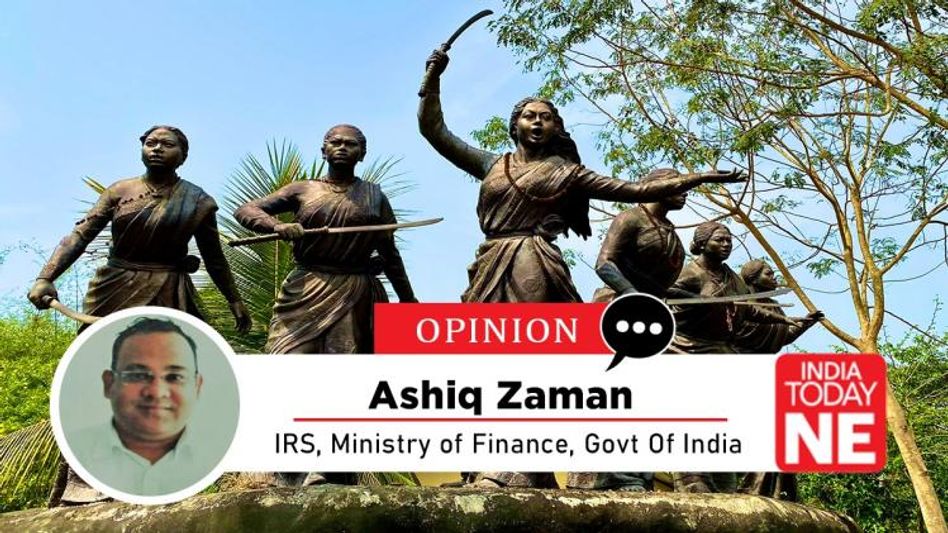Mula Gabharu and the Kavach Kapor: An Assamese Tragedy
During Ahom days, there was a special piece of cloth called ‘Kavach Kapor’. A kind of protective gear woven by the wife for her husband. The wife handed over the ‘Kavach Kapor’ to her husband at the time when he starts for the battlefield.
 Mula Gabharu and the Kavach Kapor
Mula Gabharu and the Kavach KaporWhen Harshavardhana was ruling over the Northern Indian stretch during the 7th century, his greatest ally was a King of the East – Kumar Bhaskarvarman, the most illustrious King of ancient Kamrup. During his reign, Kamrup extended up to Bihar. Contemporary chronicler Banabhatta in his famous book ‘ Harshacharita’ mentioned that Bhaskarvarman sent royal gifts to Emperor Harsha as a sign of mutual friendship. Bana wrote that the gifts included ‘silken clothes as autumn’s moonlight’. The fame of Assamese weavers is not new.
Textile tradition is deeply rooted in Assamese culture and is very much a part of life. When Mahatma Gandhi first visited Assam in 1921, he was so impressed by the weaving skill of Assamese women that he wrote – "Every woman of Assam is a born weaver and she weaves fairy tales in cloths".
In the historical period, different types of cotton and grasses like Simulu, Akon, Maduri, Chewa etc were used to make cloths. Among them, Simulu (Bombax Ceiba) cotton was the best. The pillows and mattresses of the royal house were always made of Simulu cotton. However, the clothes of the royal family were made of a special kind of thread called ‘Narakata Suta’. This thread was specially made for the royal family in two designated villages, one was in Kamarkuchi near Hajo and the another in Nagaon.
Ahom kings took a keen interest in dresses. Ahom King Gadadhar Singha probably created two ‘Khel’ (Occupational Group) exclusively engaged in royal dressmaking. The Hindus among them were called ‘Tanti’ and the Muslims were called ‘Jola’. It is worth mentioning here that, Chand Sai, one of the earliest disciples of Srimanta Sankardeb was a Jola by profession. Swargadeu Pratap Singh even brought weavers from South India and settled them in Sualkuchi, the small town known as Manchester of Assam for its textile legacy. Historians say that Ahom Kings were very fond of embroidery, for which they brought skilled artisans from the Mughal empire and settled them in Jorhat.
During the medieval period, apart from Assamese silk clothes, the ‘Mirijim’ blanket of the Mishing tribe had a high demand in the Assam-Bengal border trade
Chowkis. But the highest traded textile was the soft Mosquito-Net made by Assamese women.
However, undoubtedly the most fascinating story related to Assam’s textile tradition is that of Mula Gabharu. During Ahom days, there was a special piece of cloth called ‘Kavach Kapor’. A kind of protective gear woven by the wife for her husband. The wife handed over the ‘Kavach Kapor’ to her husband at the time when he starts for the battlefield.
During the reign of Ahom king Suhungmung, the Sultan of Bengal, Nasrat Shah sent his General Turbak Khan in 1553 to invade Assam. Ahom general Phrasenmung Borgohain was a military genius. His wife Mula Gabharu was the daughter of the earlier Ahom King Supimphaa. Before going to the battle, Phrasenmung met his wife and asked for the ‘Kavach Kapor’. However, Mula Gabharu could not give him the auspicious piece of cloth as she was menstruating at that time. According to some other accounts, making Kavach Kapor involves an elaborate ritualistic process. The cotton from the Simulu tree is to be collected at the midnight and before dawn the wear must be ready. However, in the hullabaloo of war Phrasenmung went to his wife at brought the daylight and asked for the Kavach Kapor. Mula Gabharu could not give him the Kavach Kapor and the general went to the battle without the protective gear. In the battle Turbak Khan treacherously killed Ahom General Phrasenmung Borgohain.
The news of Phrasenmung’s death greatly saddened his wife Mula Gabharu. She thought that her inability to provide the Kavach Kapor was the cause of his husband’s death. To avenge the death of his husband Mula Gabharu decided to go to the battlefield herself. Mula Gabharu fought bravely, created fear among the invading force and finally sacrificed her life defending her motherland. Then Ahom's army was on the verge of a complete defeat. But the bravery and sacrifice of Princess Mula Gabharu encouraged the dispirited Assamese soldiers so much that they attacked the invading force with new vigour. Soon Turbak Khan was killed and the invading army fled away behind the Karatoya river, the traditional Assam-Bengal border. The story of Mula Gabhuru and Phrasenmung is no less fascinating than a Greek Tragedy.
Copyright©2025 Living Media India Limited. For reprint rights: Syndications Today









